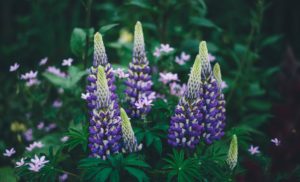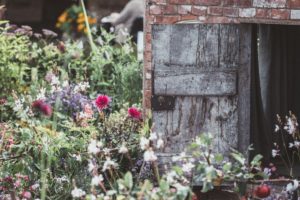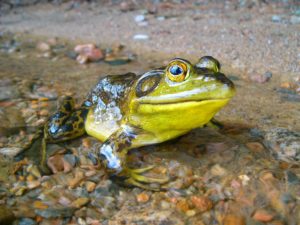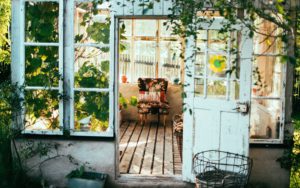I tried hard this week to come up with a way to write about racism and hate in general, but I just couldn’t get a creative, thoughtful grasp on it. No wonder. Hatred is not creative, unless in a negative sense. How many ways can I hurt or murder someone because of my judgement about their worth? Not the kind of creativity I’m interested in.

I’ve been sitting out on the front porch in the sun, relishing the breeze, watching the thumb-sized bumblebees plunder the lupine and the hummingbirds zoom around the feeder after a couple of hours of mulching, weeding, watering, trimming and planting. I haven’t been reading or writing, just drinking a large glass of mint and lemon iced tea and feeling happy, absorbing the peace and beauty of this day, enjoying the wind chimes and the sun on my skin.
Alongside the driveway we have a lupine bed. It wasn’t planned. It started, years ago, with one plant that now has become countless plants. There’s also echinacea, several kinds of wildflowers, and this year we put in pink poppies, two cleomes, lilies, sunflowers, and a starflower.
As it wasn’t a formally planned bed, the first clump of lupine went into a hole in the ground and grasses and other native growth mingle with the flowers. I’m building a border out of dead wood from our downed trees. The flowers have self-seeded and the bed sprawls, in no particular shape, most of it with undefined boundaries.
Yesterday, my partner and I were looking closely at the lupine, which is in full bloom.

I have learned, since I came to Maine, about holistic gardening and land management, and I’ve understood effective gardening is not creating a concentration camp for plants. Nature is a gardener, and a bed like ours, organic, dynamic and without any kind of fertilizer, pesticide or other chemicals, demonstrates the diversity necessary for the health of the whole system.
As we looked closely, we found a cluster of juvenile Japanese beetles on a low, sheltered leaf, and another cluster of tiny ticks. Obviously, the bed is a good nursery. A variety of bees were present. We saw a lacewing, an excellent predator, and aphids. Yellow jackets zoomed around, along with dragonflies (another welcome predator). Immature grasshoppers were plentiful, and spiders. Several kinds of butterflies floated above the flowers.
We didn’t see slugs, ants, praying mantises, caterpillars, earwigs or ladybugs, but they’re probably all present, along with mice, shrews and perhaps a mole.

The lupine and some of the grasses are now quite tall and thick. Other, later-blooming plants like echinacea are coming along, but not as high yet. As the lupine fade and lose height, the echinacea will come into its own. The bed is filled with wild low-growing plants, too, like clover, basil, grasses, dandelions, chamomile and violets. With any luck, there’s a grass snake or two under all that growth, and maybe a toad or a lizard in the cool, damp shade.
Milkweed grows there. When it blooms it will feed the endangered Monarch butterflies.
We don’t water the lupine bed, aside from giving the new seedlings a little drink when it hasn’t rained in a few days. We don’t cultivate, weed, or really mess with it in any way. The logs I’m using for a border are to help my partner when he’s mowing and keep the self-sowing lupine in check. Now and then we use our sharp little hand scythe to keep the tall grasses from overshadowing the seedlings.

Mostly, though, we just enjoy it. It’s perfect. It doesn’t need much help from us. I’m very aware the life we are able to see, both plant and animal, is dwarfed by the life in the soil, which is full of bacteria and other microorganisms, including viruses. The bed is at the foot of a tall maple stub that was more than 200 years old when it fell a couple of years ago. I would not, for any amount of money, rototill or otherwise disturb the soil, the roots of the dead tree or the layers and layers of leaves and other vegetable matter.
I will never rototill again. The best way to build soil is to build soil with layers of organic matter, all kinds of organic matter from all kinds of animals and plants. Rototilling disrupts microorganisms, mycelium and roots binding the soil together.
Diversity is balance. Diversity invites symbiosis, “a mutually beneficial relationship between different people or groups.” (Oxford online Dictionary) A diverse garden is a healthy garden in which predator and prey are balanced. Diversity includes a variety of colors and textures, growing patterns and flowering times, nutritional needs and abilities. Diversity means what we deliberately plant is just as important as native plants, otherwise known as weeds. Diversity supports the food web and the web of life.
What a concept, right? What lovely, elegant wisdom. I could never, in a million years, come up with such a complex, thriving garden as one lupine plant has created over several years at the base of a dead maple tree.

A healthy garden is filled with life and death; natural cycles and seasons; growth, blossom and decay that seeds and feeds the next cycle.
What a garden is not filled with is hatred, politics or pretence. There are no riots. There is no outrage. If one population gets out of control, either the host plant dies or the predators increase until balance is once again achieved. This life-death cycle is not personal. Viruses, insects, trees and dandelions don’t hate. They’re too busy living and reproducing or, in the case of viruses, replicating and looking for hosts.
A garden is honest, true to itself.
Dirt under my fingernails. Mosquito and black fly bites. Grubby knees. Wonder. Peace. Gratitude. Reverence for diversity. I’m in the garden.
© 2020 – 2022, Jenny Rose. All rights reserved.